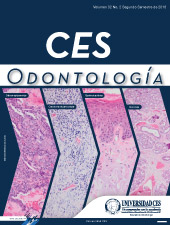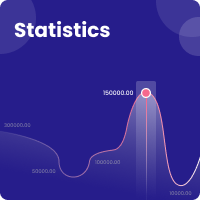Dental assessment of patients in paediatric intensive care unit (ICT)
DOI:
https://doi.org/10.21615/cesodon.31.2.1Keywords:
Intensive Care Units, Pneumonia, Ventilator-Associated, Dental Staff, HospitalAbstract
Introduction and Objective: There is need for papers involving children undergoingdental approach in hospital environment to report the clinical characteristics of thechildren attended by the Pediatric Intensive Care Unit Dentistry Service of a referencehospital of the Unified Health System (SUS) To record the oral conditions of the childrenand treatments performed by the team of professionals in Dentistry. Materialsand methods: retrospective descriptive study, through retrieval of medical recordsand results were tabulated and analyzed by means of percentage difference. Thesample consisted of 145 patients from 0 to 15 years of age attended and followed upby the UTIPed Dentistry service from September 2016 to November 2017. Patientswere analyzed for gender, age, reason for hospitalization, level of consciousness,condition of the airways, pathological processes in the oral cavity, dental proceduresperformed, oral hygiene material used and presence of PAV. Results: Patients werein the age range of less than 1 year up to 17 years, with females being more frequent(54.48%). Regarding the origin 94 (64.23%) were internal patients of the UniversityHospital and 51 (35.77%) were transferred from other hospitals. When we evaluatedthe oral health conditions, 45.83% of the patients presented satisfactory oral hygiene,45.14% regular and 9.03% deficient. Regarding oral mucosa conditions, only5.52% of the patients presented alterations, of which, 3.45% were already on admission. Conclusion: It was verified that the children hospitalized in Pediatric ICU may presentchanges in the oral mucosa from the moment of admission, being mandatory theconstant presence of the dentist in the ICU team to treat and provide a greater adherenceto the oral care of these patients.Downloads
References
Headache Classification Committee of the International Headache Society (IHS). The International Classification of Headache Disorders, 3rd edition (beta version). Cephalalgia. 1 de julio de 2013;33(9):629–808.
Escudero,JC. Discapacidad y neurociencias: la magnitud del déficit neurológico y neuro psiquiátrico. 30. 2014;4:290–9.
Bigal ME, Serrano D, Reed M, Lipton RB. Chronic migraine in the population: burden, diagnosis, and satisfaction with treatment. Neurology. 19 de agosto de 2008;71(8):559–66.
Guitera V, Muñoz P, Castillo J, Pascual J. Quality of life in chronic daily headache: a study in a general population. Neurology. 9 de abril de 2002;58(7):1062–5.
D’Amico D, Usai S, Grazzi L, Rigamonti A, Solari A, Leone M, et al. Quality of life and disability in primary chronic daily headaches. Neurol Sci Off J Ital Neurol Soc Ital Soc Clin Neurophysiol. mayo de 2003;24 Suppl 2:S97-100.
Schwedt TJ. Chronic migraine. BMJ. 24 de marzo de 2014;348:g1416.
Lipton RB, Fanning KM, Serrano D, Reed ML, Cady R, Buse DC. Ineffective acute treatment of episodic migraine is associated with new-onset chronic migraine. Neurology. 17 de febrero de 2015;84(7):688–95.
Stewart WF, Ricci JA, Chee E, Morganstein D, Lipton R. Lost productive time and cost due to common pain conditions in the US workforce. JAMA. 12 de noviembre de 2003;290(18):2443–54.
Bigal ME, Lipton RB. Modifiable risk factors for migraine progression. Headache. octubre de 2006;46(9):1334–43.
Scher AI, Midgette LA, Lipton RB. Risk factors for headache chronification. Headache. enero de 2008;48(1):16–25.
Joung D, Kim G, Choi Y, Lim H, Park S, Woo J-M, et al. The Prefrontal Cortex Activity and Psychological Effects of Viewing Forest Landscapes in Autumn Season. Int J Environ Res Public Health. 26 de junio de 2015;12(7):7235–43.
Alvarez-Bolado G, Celio MR. The ventrolateral hypothalamic area and the parvafox nucleus: Role in the expression of (positive) emotions?: Ventrolateral hypothalamic area and parvafox nucleus. J Comp Neurol. 1 de junio de 2016;524(8):1616–23.
Mejias-Aponte CA. Specificity and impact of adrenergic projections to the midbrain dopamine system. Brain Res. junio de 2016;1641:258–73.
Stone WN, Green BL, Gleser GC, Whitman RM, Foster BB. Impact of psychosocial factors on the conduct of combined drug and psychotherapy research. Br J Psychiatry J Ment Sci. noviembre de 1975;127:432–9.
Messina I, Bianco F, Cusinato M, Calvo V, Sambin M. Abnormal Default System Functioning in Depression: Implications for Emotion Regulation. Front Psychol [Internet]. 10 de junio de 2016 [citado 7 de noviembre de 2016];7. Disponible en: http://journal.frontiersin.org/Article/10.3389/fpsyg.2016.00858/abstract
Bambini V, Bertini C, Schaeken W, Stella A, Di Russo F. Disentangling Metaphor from Context: An ERP Study. Front Psychol [Internet]. 3 de mayo de 2016 [citado 7 de noviembre de 2016];7. Disponible en: http://journal.frontiersin.org/Article/10.3389/fpsyg.2016.00559/abstract
Solarte -AS. Make it happen, hacer que las cosas pasen. Introducción a la PNIT Técnica Solarte Psiconeuroinmunoterapia. Medellin-Colombia.: Paniberica; 2013. 178 p.
Breivik EK, Björnsson GA, Skovlund E. A comparison of pain rating scales by sampling from clinical trial data. Clin J Pain. marzo de 2000;16(1):22–8.
Morisky DE, Ang A, Krousel-Wood M, Ward HJ. Predictive Validity of a Medication Adherence Measure in an Outpatient Setting. J Clin Hypertens. mayo de 2008;10(5):348–54.
Hay LL. Sana tu cuerpo: las causas mentales de la enfermedad física y la forma metafísica de superarlas. Barcelona: Urano; 1992.
Doyle Strauss L, Weizenbaum E, Loder EW, Rizzoli PB. Amitriptyline Dose and Treatment Outcomes in Specialty Headache Practice: A Retrospective Cohort Study. Headache J Head Face Pain [Internet]. octubre de 2016 [citado 7 de noviembre de 2016]; Disponible en: http://doi.wiley.com/10.1111/head.12987
Pascual J. Combination therapy for chronic migraine: Bad news but not the last word. Neurology. 27 de marzo de 2012;78(13):940–1.
Hagen K, Albretsen C, Vilming S, Salvesen R, Grønning M, Helde G, et al. Management of medication overuse headache: 1-year randomized multicentre open-label trial. Cephalalgia. febrero de 2009;29(2):221–32.
Yaldo AZ, Wertz DA, Rupnow MFT, Quimbo RM. Persistence with Migraine Prophylactic Treatment and Acute Migraine Medication Utilization in the Managed Care Setting. Clin Ther. diciembre de 2008;30(12):2452–60.
Hepp Z, Bloudek LM, Varon SF. Systematic Review of Migraine Prophylaxis Adherence and Persistence. J Manag Care Pharm. enero de 2014;20(1):22–33.
Diener H-C, Holle D, Dodick D. Treatment of Chronic Migraine. Curr Pain Headache Rep. febrero de 2011;15(1):64–9.
Buse DC, Serrano D, Turkel CC, Lipton RB MA. Rates, predictors, and consequences of remission from chronic migraine to episodic migraine. Neurology. 2011;76(8):711.
Pascual J, el Berdei Y, Gómez-Sánchez JC. How many migraine patients need prolonged (>1 year) preventive treatment? Experience with topiramate. J Headache Pain. abril de 2007;8(2):90–3.
Besson JM. The neurobiology of pain. Lancet Lond Engl. 8 de mayo de 1999;353(9164):1610–5.
Olesen J, Burstein R, Ashina M, Tfelt-Hansen P. Origin of pain in migraine: evidence for peripheral sensitisation. Lancet Neurol. julio de 2009;8(7):679–90.
Downloads
Published
How to Cite
Issue
Section
License
Copyright (c) 2021 CES Odontología

This work is licensed under a Creative Commons Attribution-NonCommercial-ShareAlike 4.0 International License.
| Article metrics | |
|---|---|
| Abstract views | |
| Galley vies | |
| PDF Views | |
| HTML views | |
| Other views | |



